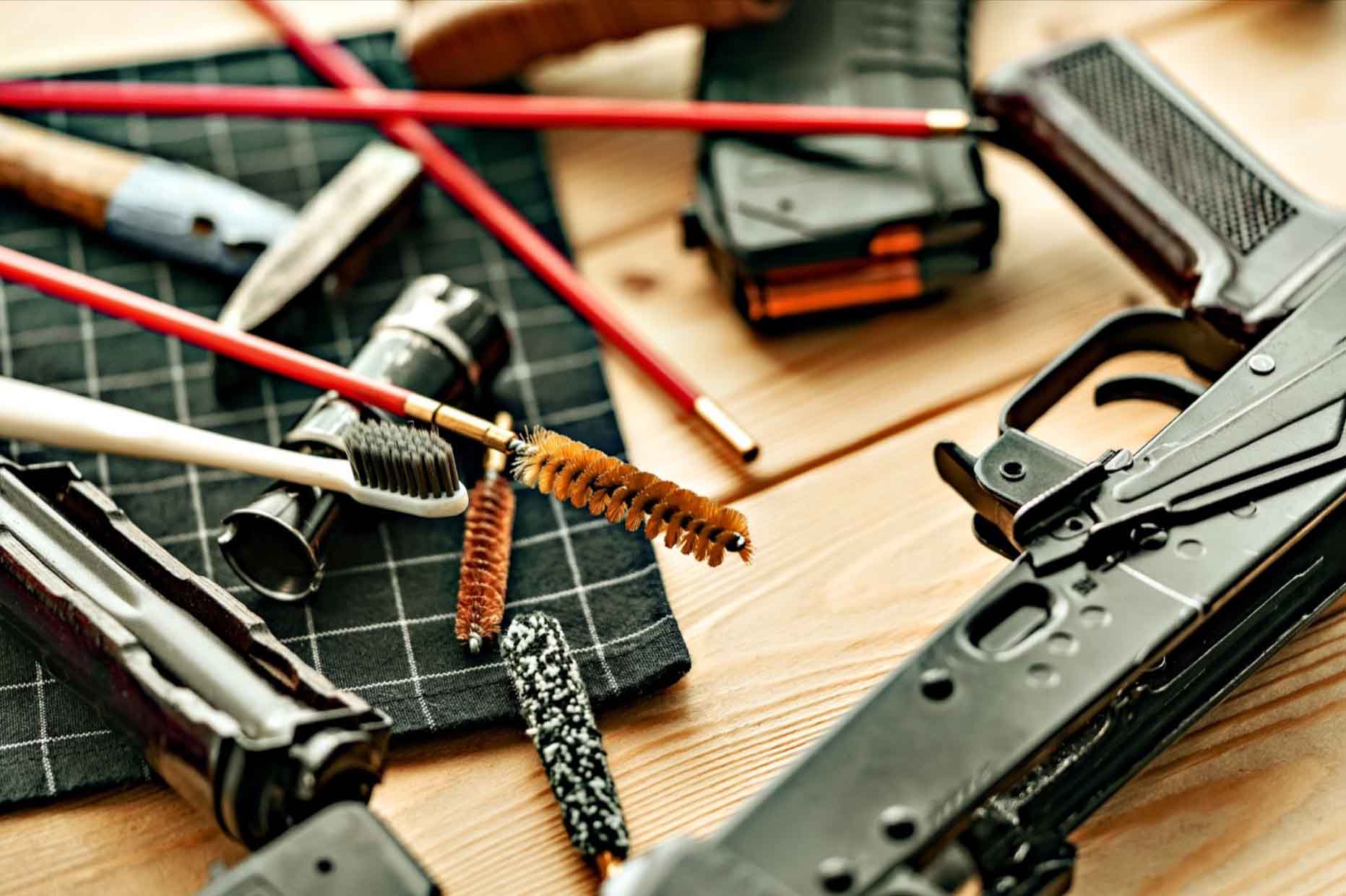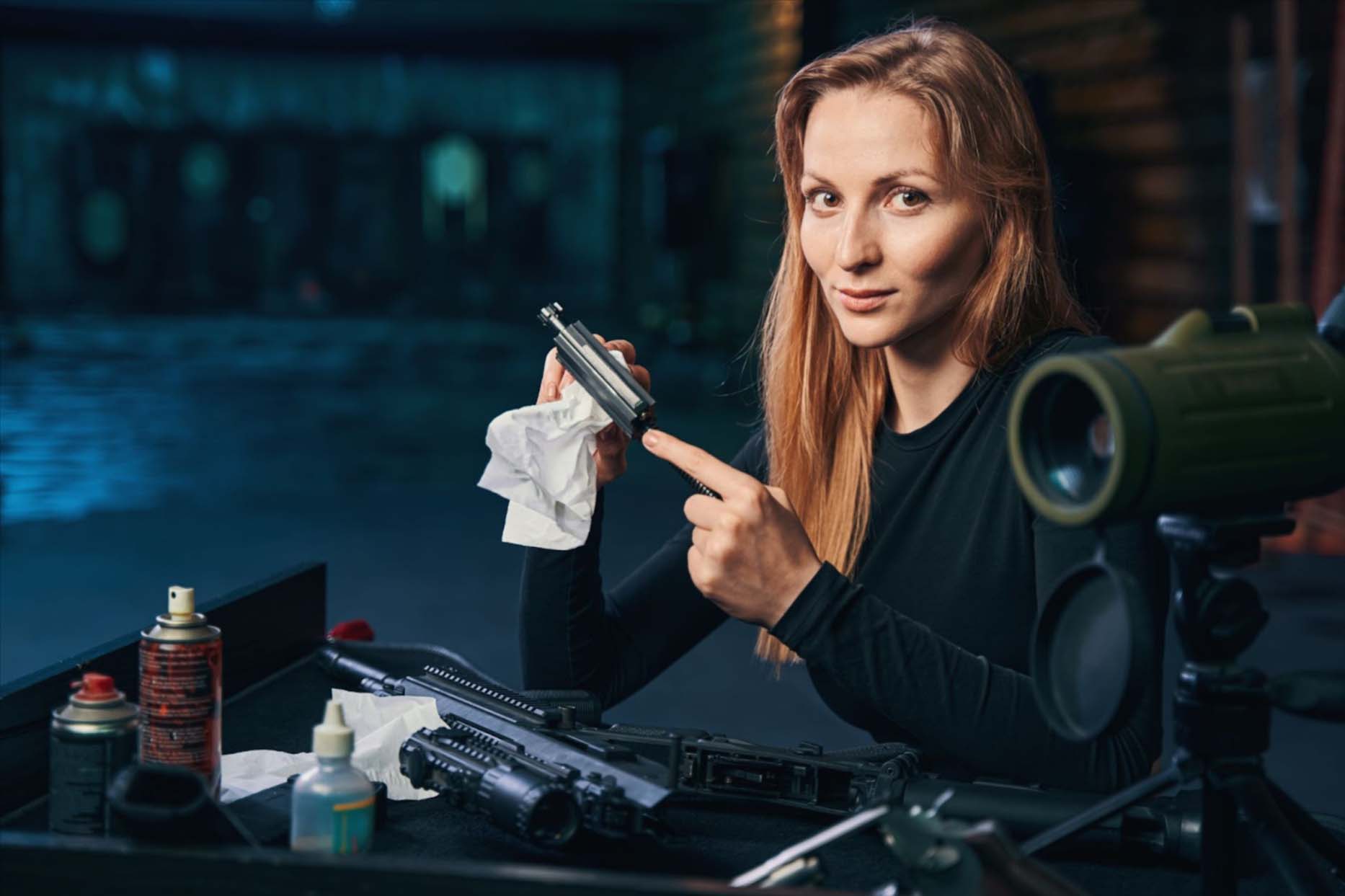Jun 27th 2024
Firearm Maintenance 101: Keeping Your Guns in Top Condition
Firearm Maintenance 101: Keeping Your Guns in Top Condition
Proper firearm maintenance ensures your guns' safety, reliability, and longevity. Whether you're a seasoned shooter or a new gun owner, understanding how to maintain your firearms will help keep them in top condition and ensure they correctly function when needed. This guide covers the basics of firearm maintenance, including cleaning, lubrication, inspection, and storage.
The Importance of Regular Cleaning
Regular cleaning is the cornerstone of firearm maintenance. When you fire your gun, residue from the ammunition, such as carbon, lead, and copper, can build up inside the barrel and other components. This buildup can affect the accuracy and reliability of your firearm. Regular cleaning helps remove these residues, ensuring your gun performs optimally and safely.
Cleaning Supplies You Will Need
Before you start cleaning your firearm, gather the necessary supplies. Basic cleaning kits typically include a cleaning rod, brushes, patches, solvent, and lubricant. You may also need a bore snake, cotton swabs, and a microfiber cloth. Using quality cleaning supplies will make the process more efficient and effective.
Step-By-Step Cleaning Process
Cleaning your firearm involves several important steps to ensure it is thoroughly cleaned and properly maintained. This process includes disassembling the firearm, applying solvent, brushing, patching, lubricating, and finally, reassembling and inspecting the firearm. Each step is crucial in maintaining the firearm's functionality and longevity.
1. Disassemble Your Firearm
Carefully disassemble your gun according to the manufacturer's instructions. Remove the magazine and check that the chamber is empty.
2. Apply Solvent
Apply a gun cleaning solvent to a bore brush or patch and run it through the barrel several times to loosen fouling and residue.
3. Brush and Patch
Use a brush to scrub the barrel and other components. Follow with clean patches until they come out without any residue.
4. Lubricate
Apply a light coat of lubricant to the moving parts of the firearm to reduce friction and wear.
5. Reassemble and Inspect
Reassemble your firearm and check for any signs of wear or damage. Ensure all parts move smoothly and correctly.

Deep Cleaning Techniques
While regular cleaning keeps your firearm in good working order, a deep cleaning is occasionally necessary to maintain peak performance. Deep cleaning involves more thorough disassembly and inspection of all components. It may include using specialized tools and solvents to reach and clean areas that are typically harder to access.
Ultrasonic Cleaners
Ultrasonic cleaners use high-frequency sound waves to agitate a cleaning solution, effectively removing dirt and residue from firearm parts. These devices are particularly useful for deep cleaning and can reach into small crevices that manual cleaning might miss. Follow the manufacturer's instructions for the best results.
Detail Stripping
Detail stripping involves fully disassembling your firearm down to its smallest components. This process allows for comprehensive cleaning and inspection of each part. If you are unfamiliar with this level of disassembly, follow the manufacturer’s guidelines or consult a professional gunsmith.
Inspecting Your Firearm
Regular inspections are crucial for identifying potential issues before they become serious problems. Inspections should be conducted during routine cleaning and involve checking for signs of wear, corrosion, or damage. Inspecting key areas include the barrel, firing pin, springs, and safety mechanisms.
Checking the Barrel
Examine the barrel for any signs of pitting, corrosion, or excessive fouling. A clean, smooth barrel is essential for accuracy and safety. Use a bore light to help you see inside the barrel more clearly.
Inspecting the Firing Pin and Springs
Ensure the firing pin moves freely and is not damaged or worn. Check the springs for any signs of fatigue or breakage, as these components are critical for the firearm's proper function.

Proper Lubrication Techniques
Lubrication is essential to reduce friction and prevent wear on moving parts. However, too much lubricant can attract dirt and debris, leading to malfunctions. Follow the manufacturer's recommendations and apply a light coat of lubricant to the key areas, such as the slide, barrel, and trigger assembly.
Choosing the Right Lubricant
Various gun lubricants are available, including oils, greases, and CLP (cleaner, lubricant, protectant) products. Choose a lubricant specifically for firearms to ensure optimal performance and protection.
Applying Lubricant
Properly applying lubricant ensures smooth and reliable firearm operation. After cleaning your firearm, use a small amount of lubricant on a cloth or patch to lightly coat the moving parts, such as the slide, barrel, and trigger assembly. Apply a light, even layer to reduce friction without attracting dirt and debris. Wipe away any excess lubricant to prevent buildup and malfunctions. Following these steps helps keep your firearm in optimal working condition and extends its lifespan.
1. Clean First
Ensure your firearm is clean before applying lubricant.
2. Light Application
Apply a small lubricant to a cloth or patch and lightly coat the moving parts.
3. Remove Excess
Wipe away any excess lubricant to prevent attracting dirt and debris.
Safe Storage Practices
Proper storage is vital for maintaining your firearm’s condition and ensuring safety. Store your guns in a cool, dry place away from moisture and extreme temperatures. Gun safes, cabinets, or cases can protect your firearms from damage and unauthorized access.
Humidity Control
Moisture can cause rust and corrosion on metal parts. Dry your storage area using silica gel packs, dehumidifiers, or other moisture control methods. Also, regularly check for signs of rust and address them immediately.
Secure Storage Solutions
Invest in a quality gun safe or cabinet to store your firearms securely. These storage solutions not only protect your guns from damage but also prevent unauthorized access, ensuring the safety of your household.
When to Seek Professional Maintenance
While routine cleaning and maintenance can be performed at home, certain situations require professional attention. Consult a qualified gunsmith if you notice unusual wear, damage, or performance issues. Regular professional inspections and maintenance can extend the life of your firearm and ensure it remains in top condition.
Professional Cleaning Services
Professional cleaning services can provide a more thorough cleaning than at home. These services often include ultrasonic cleaning, detail stripping, and comprehensive inspections, ensuring your firearm is in optimal condition.
Repairs and Modifications
If your firearm requires repairs or modifications, always seek the help of a professional gunsmith. Attempting complex repairs or modifications can lead to further damage and potential safety hazards.
The Importance of Using Quality Ammunition
Using high-quality ammunition is essential for maintaining your firearm's performance and longevity. Inferior or improperly stored ammunition can cause malfunctions and damage your gun.
Selecting the Right Ammunition
Choose ammunition appropriate for your firearm and meet manufacturer specifications. Using the correct caliber and type of ammunition ensures optimal performance and safety.
Storing Ammunition
Store ammunition in a cool, dry place away from extreme temperatures and moisture, and to prevent corrosion and degradation, use airtight containers or ammo cans with desiccant packs.
Understanding Firearm Warranties and Guarantees
Many firearms come with warranties that cover certain repairs and maintenance for a specific period. Understanding these warranties can save money and ensure your firearm is properly serviced.
Registering Your Firearm
Register your firearm with the manufacturer to fully take advantage of warranty services. This step can be crucial to claiming a warranty repair or replacement.
Reading the Warranty Terms
Familiarize yourself with the terms and conditions of your firearm’s warranty. Know what is covered, how long, and what actions might void the warranty.
Tips for Maintaining Firearm Accessories
Firearm accessories like scopes, sights, and magazines also require regular maintenance. Keeping these accessories in good condition ensures overall firearm performance.
Cleaning Optics
Regularly clean the lenses of scopes and sights using a microfiber cloth and lens cleaner. Avoid harsh chemicals that can damage the coatings on the lenses.
Maintaining Magazines
Disassemble and clean magazines periodically to remove dirt and debris. Check for signs of wear and replace springs or followers if necessary to ensure reliable feeding.
The Role of Environmental Factors in Firearm Maintenance
Environmental factors can significantly impact the condition and performance of your firearms. Awareness of these factors and proactive measures can help maintain your guns in top condition.
Impact of Humidity and Moisture
Humidity and moisture are major concerns for firearm owners. Exposure to moisture can lead to rust and corrosion, affecting the firearm's functionality and safety. Storing firearms in a controlled environment with low humidity is essential. Dehumidifiers, silica gel packs, or moisture-absorbing products in your gun safe can help protect your firearms from moisture damage.
Temperature Extremes
Extreme temperatures, both hot and cold, can also affect your firearms. High temperatures can cause lubrication to break down and metal parts to expand, while extremely low temperatures can make metals brittle and more prone to damage. Store your firearms where temperature fluctuations are minimized, and ensure they are properly lubricated to handle the environmental conditions they might be exposed to.
Dust and Debris
Dust and debris can accumulate on firearms, especially if stored or used in dusty environments. Regular cleaning and inspection can help prevent dust buildup, which can cause malfunctions and wear on moving parts. When storing firearms, use dust covers or cases to protect them from environmental contaminants.
Salt and Corrosive Environments
Firearms exposed to saltwater or used in coastal areas are at a higher risk of corrosion due to the salt and moisture in the air. If you use your firearms in such environments, clean them thoroughly after each use and apply a protective coating or rust inhibitor. This extra step will help prevent salt-induced corrosion and keep your firearms in good working condition.
Traveling With Firearms
When traveling with firearms, environmental factors such as changes in climate and exposure to elements during transport can impact their condition. Use appropriate cases that protect from impact, moisture, and temperature changes. Consider using hard-sided, lockable cases with adequate padding for air travel to ensure your firearms are safe and secure during transit.
Commitment to Firearm Maintenance
Maintaining your firearm is a crucial part of responsible gun ownership. Regular cleaning, proper lubrication, thorough inspections, and safe storage practices will keep your guns in top condition and ensure they function reliably. By dedicating time and effort to firearm maintenance, you not only extend the life of your guns but also ensure your safety and the safety of those around you.
For more tips and in-depth guides on firearm care, visit our Gunline Shooting blog. Your next step in responsible gun ownership starts here!

